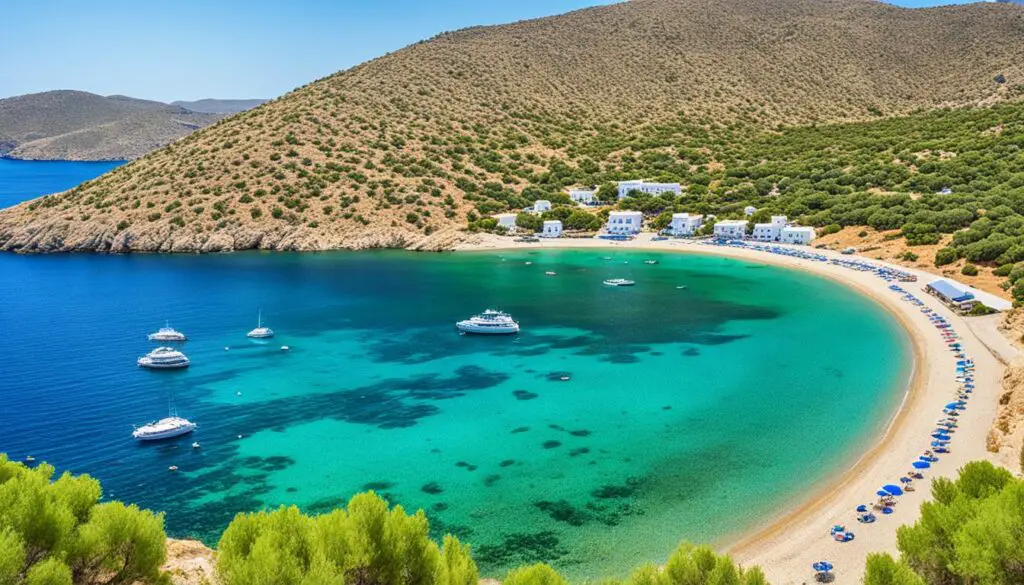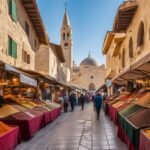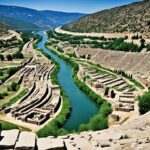Patmos, a small Greek island in the Aegean Sea, holds deep historical and theological significance in the Bible. Mentioned in various biblical accounts, it is most famously associated with the Apostle John, who lived in exile on the island and received divine visions from Jesus. These visions, recorded in the Book of Revelation, shaped Christian eschatology and prophecies about the end times.
Key Takeaways:
- Patmos has a prominent place in the Bible, associated with the Apostle John and his exile on the island.
- John’s visions on Patmos are recorded in the Book of Revelation, contributing to Christian eschatology and beliefs about the end times.
- The island’s historical and archaeological significance adds to its appeal as a biblical pilgrimage site.
- Patmos is not only spiritually significant but also offers beautiful landscapes and serene beaches for visitors to enjoy.
- Exploring Patmos allows one to delve into biblical narratives and experience its rich cultural and religious heritage.
Historical Significance of Patmos
Patmos holds tremendous historical significance as the place where the Apostle John was exiled during the 1st century. This period marks an important chapter in Christian history, demonstrating the martyrdom and persecution faced by early believers.
During John’s time, the Roman ruler Emperor Domitian instituted a severe persecution against Christians. As a result, John was banished to the island of Patmos, situated in the Aegean Sea. This exile took place around 95 AD, when John was already an elderly man.
John’s exile on Patmos was not only a personal hardship but also a turning point in the spread of Christianity. His presence on the island contributed to the development of Christian theology and strengthened the resolve of believers facing persecution.
“I, John, your brother and companion in the suffering and kingdom and patient endurance that are ours in Jesus, was on the island of Patmos because of the word of God and the testimony of Jesus.” – Revelation 1:9
Although the circumstances surrounding John’s exile are not fully detailed in historical records, it is believed that his banishment stemmed from his refusal to worship the Roman emperor as a deity. The oppressive Roman regime viewed early Christians as a threat, suppressing their religious practices and causing them immense suffering.
This historical backdrop highlights the resilience and faith of early Christians, who persisted in their beliefs despite persecution. It also serves as a testament to the enduring impact of John’s time on Patmos, as his experiences and revelations shaped the writing of the Book of Revelation.
Thus, the historical significance of Patmos lies in its association with John’s exile, a period marked by Roman persecution and the steadfastness of early Christian believers.
The Martyrdom of Early Christians
Emperor Domitian’s persecution of Christians was part of a broader effort to suppress the growth of the Christian faith. The exile of John on Patmos exemplifies the Roman Empire’s crackdown on believers, who faced hardship, imprisonment, and even death for their refusal to renounce their faith.
The accounts of John’s exile and the suffering of early Christians on Patmos remind us of the sacrifices made by believers throughout history. Their unwavering commitment to their faith in the face of persecution has inspired and strengthened subsequent generations of Christians.
| Key Points | Details |
|---|---|
| 1. John’s Exile | John was exiled to Patmos during the reign of Emperor Domitian. |
| 2. Roman Persecution | Early Christians faced intense persecution under the Roman Empire. |
| 3. Impact on Christian History | John’s exile contributed to the development of Christian theology and highlighted the resilience of early believers. |
Geographical Location of Patmos
Patmos, an enchanting Greek island situated in the Aegean Sea, belongs to the Dodecanese island group. Its strategic position in the southeastern part of the Aegean Sea has contributed to its historical significance and cultural heritage. Located approximately 60 kilometers (37 miles) off the coast of Miletus, a coastal city in present-day Turkey, Patmos served as an essential stop along the sea route from Ephesus to Rome.
Patmos in the Greek Dodecanese Islands
The Dodecanese islands, a captivating archipelago in the Aegean Sea, encompass Patmos and several other stunning destinations. With its rugged coastlines, azure waters, and charming villages, the Dodecanese offers a unique island-hopping experience for travelers to explore the diverse beauty and rich culture of the region.
Connectivity to Miletus
Miletus, once an ancient Greek city, is just a short distance away from Patmos. The proximity between Patmos and Miletus facilitated trade and cultural exchange between the Greek islands and the mainland. Today, visitors can appreciate the historical bond between these two places and explore the remnants of ancient civilizations and their interconnectedness.
Archaeological Discoveries on Patmos
Archaeological excavations on Patmos have revealed remarkable ruins and artifacts that provide valuable insights into the island’s ancient history. These discoveries offer a glimpse into the vibrant life and activities that once thrived on Patmos during ancient times.
Ancient Acropolis: Kastelli
One of the most prominent archaeological sites on Patmos is the ancient acropolis known as Kastelli. This fortified hilltop served as the administrative and cultural center of the island. Excavations have unearthed remnants of buildings, walls, and structures, shedding light on the island’s governance and cultural practices.
Outlying Villages and Settlements
Apart from the ancient acropolis, archaeological digs have also uncovered the remains of outlying villages and settlements on Patmos. These findings provide a deeper understanding of the daily life, architecture, and social dynamics of the people who lived there thousands of years ago.
Hippodrome and Pagan Temples
Furthermore, excavations have revealed the existence of a hippodrome on Patmos, indicating the island’s involvement in ancient sports and entertainment. Additionally, the discovery of pagan temples suggests the prevalence of ancient religious practices on the island.
The archaeological discoveries on Patmos contribute to the broader understanding of the island’s historical significance and its role in the ancient world. They highlight the rich cultural heritage and offer a glimpse into the lives of those who laid the foundations for the island’s fascinating past.
Theological Themes in Patmos
Patmos holds a significant place in theological discussions, particularly due to its association with the biblical Book of Revelation. The visions received by John on the island formed the basis of this apocalyptic book, which explores profound theological themes.
Themes of Judgment, Redemption, and Victory
The Book of Revelation delves into themes of judgment, redemption, and the ultimate victory of good over evil. It presents a vivid depiction of the end times and the Second Coming of Christ, offering insights into the divine plan for humanity’s salvation.
The Book of Revelation reveals the unfolding of God’s judgment upon the world, the redemption of the faithful, and the eventual triumph of good over evil. It holds a message of hope, urging believers to persevere and remain steadfast in their faith.
The theological depth and symbolism found in the Book of Revelation have had a profound impact on Christian theology and eschatological beliefs. The text has sparked extensive debates and interpretations among biblical scholars and theologians, seeking to unravel its meanings and implications.
Influence on Christian Eschatology
The Book of Revelation’s portrayal of the end times and its visions of a new heaven and earth have significantly influenced eschatological beliefs within Christianity. It has shaped understandings of the final judgment, the resurrection of the dead, and the eternal destiny of humanity.
Patmos, as the place where these visions were revealed to John, has become a focal point for those studying and contemplating these theological themes. Biblical scholars and theologians often visit the island to gain insights and deepen their understanding of the Book of Revelation’s eschatological significance.
An Image Depicting Theological Themes

The image above captures the essence of the theological themes present in Patmos. It serves as a visual reminder of the awe-inspiring visions received by John on the island and the profound impact they have had on Christian theology and eschatology.
Key Biblical Events on Patmos
The key biblical event associated with Patmos is the exile and visions of the Apostle John. According to biblical accounts, John received divine revelations and visions while on the island, which he recorded in the Book of Revelation. These visions depict the end times, the Second Coming of Christ, and the final judgment.
“And I turned to see the voice that was speaking with me. And having turned, I saw seven golden lampstands, and in the middle of the lampstands was one like a son of man. . . . And He had in His right hand seven stars, and out of His mouth came a sharp two-edged sword; and His face was like the sun shining in its strength.” – Revelation 1:12-16
John’s visions on Patmos reveal profound insights into the future events that would unfold, providing a glimpse into the ultimate plan of God for humanity. These visions continue to captivate believers and scholars alike, inspiring deeper contemplation and exploration of the mysteries contained within the Book of Revelation.
Significance of John’s Visions
The Book of Revelation, also known as the Apocalypse of John, holds immense theological and eschatological significance. It serves as a guide and source of hope for Christians, assuring them of God’s ultimate victory over evil and the promise of eternal life in His Kingdom.
The vivid imagery, symbolic language, and prophecies presented in the Book of Revelation have ignited debates, interpretations, and discussions among scholars and theologians throughout history. Its cautionary messages, profound insights, and timely reminders continue to resonate with believers, encouraging them to remain faithful and steadfast in their faith.
Key Visions in the Book of Revelation
| Event/Visions | Description |
|---|---|
| The Seven Seals | Revealing the judgments and events leading to the end times. |
| The Four Horsemen | Symbolizing conquest, war, famine, and death. |
| The Great Tribulation | Describing a time of unprecedented suffering and persecution. |
| The Beast and False Prophet | Depicting powerful forces aligned against God’s people. |
| The Millennial Reign | Illustrating the reign of Christ on Earth for a thousand years. |
| The New Heaven and New Earth | Portraying the eternal dwelling place for believers. |
These visions present a captivating narrative, highlighting the ultimate triumph of good over evil and the eternal hope found in God’s promises. They continue to inspire believers to live with anticipation and readiness for the second coming of Christ.
Cultural and Religious Practices on Patmos
Patmos is known for its rich cultural and religious practices, deeply rooted in its association with the Greek Orthodox Church. At the heart of the island stands the Holy Monastery of St. John the Theologian, a significant religious site and a center of worship. This UNESCO World Heritage Site attracts thousands of pilgrims and visitors each year who come to experience its spiritual ambience and historical significance.
One of the prominent cultural practices on Patmos is the celebration of Holy Week and Easter. During this time, the island comes alive with vibrant processions, liturgical ceremonies, and traditional rituals. The streets of Chora, the capital of Patmos, are adorned with flowers and decorated with symbolic representations of Jesus’ crucifixion and resurrection. The faithful gather at the Holy Monastery of St. John the Theologian to attend solemn services and partake in the Holy Communion.
“The Holy Monastery of St. John the Theologian has been a place of deep devotion and religious reverence for centuries. It is not just a religious site but also the center of the island’s cultural and spiritual identity.”
The cultural practices on Patmos are deeply intertwined with the religious traditions of the Greek Orthodox Church. The island’s churches and chapels play a significant role in the community’s religious life, hosting regular worship services, weddings, and baptisms. The islanders have a strong connection to their faith and actively participate in religious events throughout the year.
Additionally, Patmos is home to several religious festivals that showcase the island’s cultural heritage. The Feast of Saint John the Theologian, celebrated on May 8th, attracts pilgrims from all over Greece and beyond. The festival includes religious services, processions, traditional dances, and music, creating an atmosphere of joy and devotion.
The local cuisine of Patmos is also influenced by its religious traditions. During religious holidays and celebrations, traditional dishes and sweets are prepared, often using locally sourced ingredients. This culinary heritage reflects the island’s rich history and cultural identity.

The cultural and religious practices on Patmos not only offer a glimpse into the island’s past but also provide a unique and immersive experience for visitors. The blending of spirituality, tradition, and community creates an atmosphere of reverence and deepens one’s understanding of the Greek Orthodox faith and the cultural tapestry of Patmos.
Prophetic and Eschatological Significance of Patmos
The visions received by John on Patmos have a profound prophetic and eschatological significance. The Book of Revelation, with its detailed descriptions of the end times and the return of Christ, has shaped beliefs and interpretations regarding the future of humanity. Patmos, as the place where these visions were revealed, holds a unique place in the context of biblical prophecy and the study of eschatology.
The Book of Revelation: Unveiling the End Times Prophecy
Embedded within the pages of the Bible lies a captivating narrative known as the Book of Revelation. This prophetic book, written by the Apostle John during his exile on the island of Patmos, offers a glimpse into the eschatological beliefs and apocalyptic visions that continue to intrigue and inspire believers today.
In the Book of Revelation, John shares his encounters with heavenly beings, vividly describing cataclysmic events, spiritual warfare, and ultimately, the triumph of good over evil. His writings paint a picture of the end times, the unveiling of divine judgment, and the ultimate establishment of God’s eternal kingdom.
“And I saw the holy city, new Jerusalem, coming down out of heaven from God, prepared as a bride adorned for her husband” – Revelation 21:2
This powerful biblical text has sparked countless interpretations and debates, influencing eschatological beliefs across various Christian traditions. Scholars and theologians continue to study the intricate symbolism and motifs contained within the Book of Revelation, seeking to understand its prophetic messages and their relevance to contemporary times.
The Significance of Patmos in Biblical Prophecy
Patmos, as the location where John received these divine revelations, holds a special place in the realm of biblical prophecy. The island’s prophetic significance transcends its mere physical presence, becoming a symbol of spiritual transformation and divine communication.
The serene beauty and solitude of Patmos provide an environment conducive to introspection and communion with the divine. It was within this sacred space that John’s prophetic visions unfolded, offering a glimpse into the future and providing insights into the ultimate fulfillment of God’s plan for humanity.
From the iconic image of a heavenly city descending to the detailed descriptions of cosmic events and divine judgments, the prophetic significance of Patmos lies in its role as a conduit for divine revelation. The island stands as a testament to the enduring power of God’s message and the magnitude of eschatological beliefs.
The Continuing Influence of Patmos
Centuries after John’s exile on Patmos and the writing of the Book of Revelation, the island continues to captivate the hearts and minds of believers. Patmos remains a destination for spiritual pilgrims who seek to connect with the prophetic legacy and delve deeper into the realms of biblical eschatology.
Visitors to Patmos have the opportunity to explore the ancient sites associated with John’s stay, including the Cave of the Apocalypse where he is said to have received the visions. The Holy Monastery of St. John the Theologian, a UNESCO World Heritage site, stands as a testament to the enduring spiritual significance of Patmos.

Whether one approaches Patmos as a believer or a curious traveler, the island’s prophetic and eschatological significance offers a window into the mystical and intriguing aspects of biblical prophecy. It is a place to contemplate the ultimate destiny of humanity, the divine plan set in motion, and the hope that lies beyond the veil of the present age.
Panoramic Beauty of Patmos
Patmos is renowned for its panoramic beauty and stunning landscapes. The island’s whitewashed houses, narrow streets, and picturesque villages, such as Chora, create a charming and postcard-worthy backdrop.
Patmos also boasts beautiful beaches, clear blue waters, and rocky cliffs, making it an ideal destination for nature lovers and those seeking scenic tranquility. Whether you’re admiring the scenic views from a cliffside vantage point or basking in the sun on one of Patmos’ pristine beaches, the Greek island landscapes are sure to leave you in awe.

The natural beauty of Patmos is truly captivating. The combination of rugged cliffs, crystal-clear waters, and lush greenery makes it a paradise for photographers and nature enthusiasts.
Exploring Patmos allows you to immerse yourself in its panoramic beauty and discover the hidden wonders of this Greek island. Whether you’re strolling through the charming streets of Chora, enjoying a peaceful moment on a secluded beach, or taking in the breathtaking vistas from a hilltop, Patmos offers a serene and mesmerizing escape.
Serene Beaches of Patmos
When visiting Patmos, one cannot miss the opportunity to explore its serene and breathtaking beaches. With crystal-clear waters and stunning views, these beaches offer the perfect setting for relaxation and enjoyment. Let’s discover three popular beach destinations in Patmos:
Skala Beach
Skala beach is a beloved spot for both locals and tourists alike. Its golden sand and gentle waves create a welcoming atmosphere for sunbathers and swimmers. The beach is conveniently located near the island’s main port, making it easily accessible for visitors. Whether you’re looking to soak up the sun or take a refreshing dip in the Aegean Sea, Skala beach is a must-visit destination on Patmos.
Agriolivado Beach
Agriolivado beach is known for its picturesque beauty and tranquil ambiance. Surrounded by lush vegetation and olive groves, this beach offers a peaceful escape from the bustling city life. The clear turquoise waters and soft sandy shore make it an ideal spot for sun-seekers and nature enthusiasts. Agriolivado beach is the perfect place to unwind and immerse yourself in the natural wonders of Patmos.
Rainbow Beach
Named after its unique feature, Rainbow beach is famous for its multi-colored pebbles that span the shoreline. These vibrant stones create a mesmerizing sight, complementing the crystal-clear waters of the Aegean Sea. Rainbow beach offers a tranquil and secluded setting, making it a favorite among those seeking privacy and seclusion. Whether you’re looking to take a leisurely stroll or simply admire the natural beauty, Rainbow beach is a hidden gem waiting to be discovered on Patmos.
From relaxing under the sun to exploring the vibrant underwater world, Patmos beaches provide a variety of experiences for beach lovers. Don’t miss the opportunity to visit Skala beach, Agriolivado beach, and Rainbow beach to create unforgettable memories on this beautiful Greek island.

Conclusion
Patmos, with its biblical significance, historical importance, and captivating attractions, is a destination that offers a truly unique experience for visitors. As a Christian pilgrimage site, it holds a special place in the hearts of believers, allowing them to explore the biblical narratives and walk in the footsteps of the Apostle John.
But Patmos is not just for religious pilgrims. Its archaeological discoveries, such as the ancient acropolis and ruins, offer a glimpse into the island’s rich past and make it a fascinating site for history enthusiasts. Moreover, its panoramic beauty, with its whitewashed houses, narrow streets, and picturesque villages, make it a visually stunning place to explore.
From the serene beaches like Skala beach, Agriolivado beach, and Rainbow beach, to the vibrant cultural and religious practices, Patmos has something for everyone. Whether you seek spiritual enlightenment, a journey through history, or simply a peaceful retreat in nature, exploring Patmos will leave you with lasting memories and a deeper appreciation for its cultural and religious heritage.







